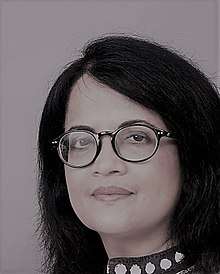Dilruba Z. Ara
Dilruba Z. Ara (born 20 November 1957) is a Swedish Bangladeshi writer,[1][2][3] novelist, artist, educator and translator.[4]
Dilruba Z. Ara | |
|---|---|
 | |
| Born | 20 November 1957 Dhaka, Bangladesh |
| Occupation | Writer, translator, painter, educator |
| Language | English, Bengali |
| Nationality | Swedish Bangladeshi |
| Citizenship | Sweden, Bangladesh |
| Alma mater | Gothenburg University (Fil.Kand.) Lund University (B.Ed.) |
| Notable works |
|
| Children |
|
Background
Ara was born into a distinguished literary family in Bangladesh. Her father, Shahed Ali, was a Language Movement veteran, translator and Bangla Academy award-winning author of the famous Gabriel’s Wings.[5] Her mother, Professor Chemon Ara, now retired, is also an acknowledged author and Language Movement veteran.
Career
Education
Bachelor of Education: Lund University, Sweden.
Alma Mater: Gothenburg University, Sweden.
Bibliography
Short stories
Published in Chattahoochee Review, Drunken Boat, Asia Writes, Democratic World Magazine, Swedish Institute, The Daily Star, Shipwrights Review and Vista.
Personal life
Ara moved to Sweden in 1978 and has lived in the university town of Lund since 2007. Her son, Navid, now an architect, lives and works in Malmö. Her daughter, Tania, a student at the Royal Institute of Technology, lives in Stockholm. Ara travels to Dhaka frequently, where her mother Professor Chemon Ara still lives in their family home in Banani. Her father Shahed Ali passed away in 2001.
References
- Ara, Dilruba Z. (2006). A list of offences. Bangladesh: University Press Ltd. ISBN 978-1477481875.
- Ara, Dilruba Z. (2015). Blame. Bangladesh: University Press Ltd. ISBN 978-9845062336. OCLC 1001708582.
- Ara, Dilruba Z. (2016). Detached Belonging. Bangladesh: University Press Ltd. ISBN 978-9845062435. OCLC 967589139.
- Ali, Shahed; Ara, Dilruba Z. (2006). Selected short stories of Shahed Ali. Bangladesh: University Press Ltd. ISBN 978-9840517626. OCLC 607247307.
- Haque, Junaidul (28 May 2016). "Ethos behind a war". The Daily Observer.
- Grooms, Anthony (March 2008). "A Woman's View". connection.ebscohost.com. Retrieved 2018-04-11.
- Mortuza, Shamsad (8 February 2016). "Whose blame is it anyway?". The Daily Star. Retrieved 2018-04-11.
- Haque, Junaidul (20 May 2016). "Blame: A 1971 novel". Dhaka Tribune. Retrieved 2018-04-11.
- Holmberg, Claes-Göran (12 August 2013). "Portraying man's vulnerability". The Daily Star. Retrieved 2018-04-11.
- "At a glance". The Daily Star. 3 November 2007. Retrieved 2018-04-11.
External links
- Official website
- Interview with Dilruba Z. Ara at The Daily Observer, Bangladesh
- Published works at WorldCat Identities
- Princeton University Library Catalogue
- Dilruba Z. Ara speaks at Independent University, Bangladesh
- Books by Dilruba Z. Ara at The University Press Limited
- Book review (La Lista de Ofensas) at Oceano Publishing House, Mexico
- Book review (La Lista de Ofensas) at La Librería de Javier, Madrid
- Bangladeshi Writers Abroad at Bangladesh Circle
- The Mosque-Yard Imam by Dilruba Z. Ara at Democratic World, India
- Affection by Dilruba Z. Ara at Drunken Boat, USA